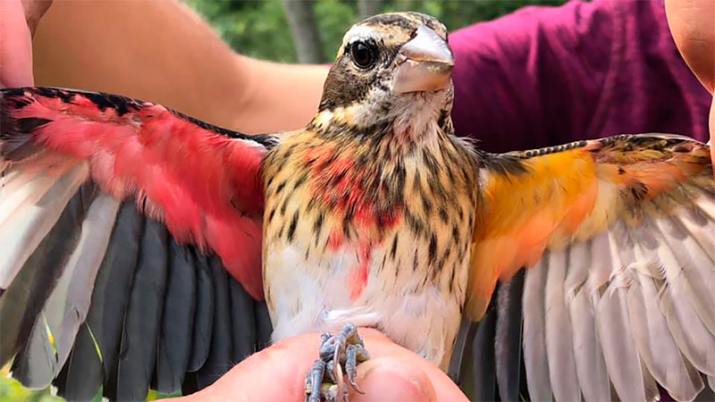Researchers at the Powdermill Nature Reserve in Pennsylvania recently came across a “once in a lifetime discovery” – a half-male, half-female rose-breasted grosbeak.
Annie Lindsay and her colleagues at Powdermill Nature Reserve were catching and banding birds with identification tags on September 24, when a fellow researcher called her over via walkie-talkie to supposedly see something extraordinary.
The moment she saw her colleague’s find, Annie knew what she was looking at, an extremely rare half-male, half-female creature known as a gynandromorph. The rose-breasted grosbeak exhibited male-characteristic plumage on one half of its body, and female coloration on the other.
“It was spectacular. This bird is in its nonbreeding [plumage], so in the spring when it’s in its breeding plumage, it’s going to be even more starkly male, female,” Annie Lindsay, banding program manager at Powdermill, said. “The bird’s colors will become even more vibrant, and “the line between the male and female side will be even more obvious.”
https://www.facebook.com/PowdermillNatureReserve/photos/a.603279613104188/3156585397773584/?type=3
Photos taken by the researchers show that the gynandromorph rose-breasted grosbeak has black feathers and a pink armpit characteristic of males, on one side, and brown feathers and a yellow-colored armpit, on the other. It even has a line that runs roughly down its middle, separating the two halves. Scientists say that if the bird is like previously-studied gynandromorphs, its male-specific separation appears on the inside as well, meaning the bird has a half-male, half-female brain as well as reproductive organs.
https://www.facebook.com/PowdermillNatureReserve/photos/a.603279613104188/3156585324440258/?type=3
Unlike hermaphrodites, which have both male and female reproductive organs, gynandromorphs are male on one side of the body, and female on the other. Because of how rare these specimens are, there are many things that scientists don’t know about them, such as if they are able to reproduce. In 64 years of bird banding, Powdermill’s Avian Research Center has only recorded less than 10 gynandromorph sightings.
https://www.facebook.com/PowdermillNatureReserve/photos/a.603279613104188/3156585274440263/?type=3
“The entire banding team was very excited to see such a rarity up close, and are riding the high of this once-in-a-lifetime experience,” Lindsay wrote on Facebook. “One of them described it as ‘seeing a unicorn’ and another described the adrenaline rush of seeing something so remarkable. They all are incredibly grateful to be part of such a noteworthy and interesting banding record. Bilateral gynandromorphism, while very uncommon, is normal and provides an excellent example of a fascinating genetic process that few people ever encounter.”





No comments! Be the first commenter?